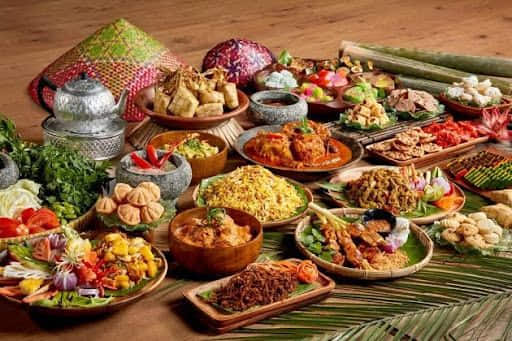
Image Source: https://thepatriots.asia/hidangan-hari-raya-aidilfitri-dunia/
Hari Raya Aidilfitri, also known as Eid al-Fitr, is a joyous celebration that marks the end of Ramadan. One of the highlights of this festive occasion is the delicious spread of traditional foods that are prepared and enjoyed by families and friends. These traditional foods hold deep cultural significance and are a must-try during Hari Raya Aidilfitri.
Introduction to Hari Raya Aidilfitri

Image Source: https://www.freepik.com/
Hari Raya Aidilfitri, also known as Eid al-Fitr, is one of the most important festivals celebrated by Muslims around the world. It marks the end of Ramadan, the holy month of fasting. This joyous occasion is a time for Muslims to come together with family and friends to celebrate and give thanks for the blessings they have received.
One of the highlights of Hari Raya Aidilfitri is the abundance of traditional foods that are prepared and enjoyed during this festive period. These dishes hold great significance and are an integral part of the celebrations.
The traditional foods served during Hari Raya Aidilfitri are not only delicious but also hold deep cultural and symbolic meanings. They reflect the diversity and richness of Malaysian cuisine, as well as the customs and traditions passed down through generations.
Sharing meals with family, friends, and neighbors is an important aspect of Hari Raya Aidilfitri. It is a time when people open their homes and hearts to welcome others to join in the festivities. The act of sharing meals represents unity, love, and generosity, and it strengthens the bonds between individuals and communities.
Rendang: A Must-Try Dish

Source Image: https://pixabay.com/
Rendang, a flavorful and aromatic dish, is a must-try traditional food during Hari Raya Aidilfitri. This beloved dish holds a significant place in Malay cuisine and is enjoyed by many during festive celebrations.
The origin of rendang can be traced back to the Minangkabau people of Indonesia, specifically from the region of West Sumatra. It is believed to have been brought to Malaysia by the Minangkabau immigrants, who settled in the Negeri Sembilan state.
Rendang is traditionally prepared by slow-cooking meat, usually beef or chicken, in a rich blend of spices and coconut milk. The dish is known for its complex flavors, achieved through a careful combination of ingredients such as lemongrass, galangal, turmeric, ginger, garlic, and chili peppers. The slow-cooking process allows the meat to absorb all the flavors, resulting in tender and succulent rendang.
While rendang is most commonly associated with beef, there are also variations using other meats like chicken, lamb, or even goat. Each region in Malaysia has its own unique take on rendang, with slight variations in ingredients and cooking techniques. For example, in the northern states of Malaysia, rendang is typically spicier compared to the milder rendang found in the southern regions.
Whether you prefer the rich and creamy beef rendang or the fiery chicken rendang, experiencing the diverse rendang flavors across Malaysia is a culinary adventure worth embarking on during Hari Raya Aidilfitri.
You can do grocery shopping online for the ingredients, so there’s no need to go out to buy them from a physical store. Additionally, you can buy these foods online as well because GrabFood offers a variety of food vendors that offer rendang, lemang, ketupat, and other traditional delicacies, making it convenient for you to enjoy these dishes from the comfort of your home.
Lemang and Ketupat: Traditional Rice Delights

Image Source: https://unsplash.com/
During Hari Raya Aidilfitri, no celebration is complete without the presence of lemang and ketupat. These traditional rice delights hold a special place in the hearts of Malaysians and are a must-have on the festive menu. Let’s explore the traditional methods of cooking lemang and ketupat, the accompaniments and condiments that complement them, and the symbolic meaning behind these beloved dishes.
When it comes to lemang, the traditional method of cooking involves using bamboo tubes lined with banana leaves. Glutinous rice, coconut milk, and salt are carefully layered inside the bamboo tubes, which are then placed over an open fire. The heat slowly cooks the rice, resulting in a deliciously fragrant and slightly smoky dish. This age-old technique imparts a unique flavor to the lemang, making it a true delicacy.
Ketupat, on the other hand, is made by weaving young coconut leaves into a pouch-like shape. The pouch is then filled with glutinous rice and boiled until the rice is cooked. The woven coconut leaves give ketupat its distinctive diamond shape and impart a subtle aroma to the rice. The process of making ketupat requires skill and precision, and it is often a communal activity that brings families and friends together.
Lemang and ketupat are typically enjoyed with an array of accompaniments and condiments. The most common condiment is serunding, which is a savory meat floss made from beef or chicken. Serunding adds a burst of flavor and texture to the already delicious lemang and ketupat. Other popular accompaniments include rendang (a rich and spicy meat dish), sambal (a chili-based sauce), and pickles. These accompaniments complement the rice delights and elevate the overall dining experience.
Aside from their culinary appeal, lemang and ketupat also hold symbolic meaning during Hari Raya Aidilfitri. They represent unity, togetherness, and gratitude. The process of preparing these dishes requires patience, cooperation, and teamwork, reflecting the spirit of harmony and kinship that defines the festive season. Lemang and ketupat are not just food; they are a symbol of the shared values and traditions that bind communities together.
Kuih: Sweet Treats for Hari Raya

Image Source: https://www.xtra.com.my/eat-travel/12-jenis-kuih-raya-yang-paling-popular-setiap-kali-hari-raya-aidilfitri/
Kuih, also known as traditional Malay sweets, are an integral part of Hari Raya Aidilfitri celebrations. These delectable treats are enjoyed by Muslims in Malaysia and other Southeast Asian countries during this festive season. Let’s explore the popular types of kuih, their traditional recipes and cooking techniques, as well as their symbolism and cultural significance.
During Hari Raya, a wide variety of kuih can be found in every household. Some of the most popular types include:
- Kuih Lapis: This colorful layered cake is made from rice flour, coconut milk, and pandan juice. Its vibrant appearance makes it a standout dish on the festive table.
- Kuih Seri Muka: A combination of glutinous rice and pandan custard, this kuih is often adorned with a layer of coconut milk on top.
- Kuih Bahulu: These bite-sized sponge cakes are a favorite among children and adults alike. They are usually baked in special molds, resulting in their unique shape.
Preparing kuih requires time, patience, and skill. Many traditional recipes have been passed down through generations, ensuring the preservation of these culinary treasures. The cooking techniques may vary, but they often involve steaming, frying, or baking.
Aside from their delightful taste, kuih holds a special meaning in Malay culture. These sweet treats symbolize unity, harmony, and the joy of togetherness. They are often shared with family, friends, and neighbors as a gesture of goodwill and love during Hari Raya.
So, when you celebrate Hari Raya Aidilfitri, don’t forget to indulge in these mouthwatering kuih. Their unique flavors and cultural significance will undoubtedly enhance the festive spirit.
Serunding: Savory Meat Floss

Image Source: https://www.maggi.my/en/recipes/chicken-floss/
Serunding is a popular traditional food that is commonly enjoyed during Hari Raya Aidilfitri celebrations. This flavorful dish is made from finely shredded or minced meat that is cooked until it becomes dry and crispy, resembling floss. Serunding is typically served as a condiment or topping for various dishes, adding a burst of savory goodness.
When it comes to the ingredients used in serunding, the most common meat options include beef, chicken, and fish. These meats are carefully selected and seasoned with a blend of aromatic spices such as lemongrass, ginger, garlic, and shallots. The meat is then slow-cooked until it reaches the perfect texture and flavor.
The preparation methods and cooking techniques for serunding require patience and attention to detail. The meat is first boiled or steamed until it is tender, then it is finely shredded or minced. Next, it is stir-fried in a wok or pan with a mixture of spices, coconut milk, and sometimes dried shrimp for added umami flavor. The process of cooking serunding is time-consuming, but the result is a delicious and aromatic dish that is worth the effort.
One of the fascinating aspects of serunding is the variety of flavors and variations available. Besides the traditional beef, chicken, and fish serunding, there are also unique versions made from other meats such as lamb or even vegetarian options like jackfruit. Each variation offers a distinct taste profile, allowing individuals to explore different flavors and find their favorite.